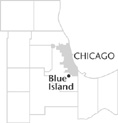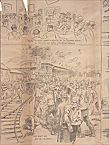| Entries |
| B |
|
Blue Island, IL
|
 Cook County, 16 miles S of the Loop. Blue Island stands on the southern end of an ancient
glacial
ridge five miles long, extending northward along Western Avenue and Vincennes Road from 131st Street to 87th Street. The ridge stood as an island in glacial Lake Chicago, the predecessor of
Lake Michigan.
Bands of
Ottawas,
Ojibwas,
and
Potawatomi
lived along the Little Calumet River and Stony Creek until 1835.
Cook County, 16 miles S of the Loop. Blue Island stands on the southern end of an ancient
glacial
ridge five miles long, extending northward along Western Avenue and Vincennes Road from 131st Street to 87th Street. The ridge stood as an island in glacial Lake Chicago, the predecessor of
Lake Michigan.
Bands of
Ottawas,
Ojibwas,
and
Potawatomi
lived along the Little Calumet River and Stony Creek until 1835.
To a springtime traveler on the Vincennes Trail, the glacial bluff that rose out of the prairie south of Chicago took on a bluish hue from haze or blue wildflowers. In 1836 the first inn opened along the Vincennes Trail at Blue Island. Excavation of a Calumet–Blue Island feeder canal in the 1840s diverted water from the Little Calumet River to the Illinois & Michigan Canal near Lemont. Transplanted Yankees established the village as an agricultural market center. German agricultural laborers began arriving in the 1850s, and by the 1890s they had usurped political and economic power from the Yankees.
Small-scale factories, brickyards, breweries, and cigar shops arose after 1880. Between 1886 and 1889 workers affiliated with Knights of Labor Local Assembly 6581, and in 1893, organized Local 3 of what became the United Brick and Clay Workers Union.

|
In 1901 Blue Island incorporated as a city to avoid annexation by Chicago. In 1915 residents rejected annexation while nearby Morgan Park joined Chicago. Italians, Poles, and Slovaks settled in Blue Island between 1900 and 1920, but African Americans who were excluded from the town incorporated Robbins in 1917. Population plateaued at 16,000 to 21,000 between 1930 and 1990. Despite chain stores and Western Avenue's designation as the Dixie Highway in the 1920s, the central business district declined. Political and fiscal conservatism blocked annexation of the future Alsip industrial district. Landlocked industries left the city. During the 1990s, however, the city appeared to revive slowly. Old industries such as Modern Drop Forge and Clark Oil Refineries thrived, while antique stores, theaters, and Mexican restaurants lined Western Avenue.
| Blue Island, IL (inc. 1843) | |||||
| Year |
Total
(and by category) |
Foreign Born | Native with foreign parentage | Males per 100 females | |
| 1900 | 6,114 | 24.8% | 46.4% | 101 | |
| 6,110 | White (99.9%) | ||||
| 1 | Negro (0.0%) | ||||
| 3 | Chinese (0.0%) | ||||
| 1930 | 16,534 | 15.7% | 39.2% | 103 | |
| 16,216 | White (98.1%) | ||||
| 9 | Negro (0.1%) | ||||
| 309 | Other (1.9%) | ||||
| 1960 | 19,618 | 8.3% | 25.8% | 96 | |
| 19,295 | White (98.4%) | ||||
| 319 | Negro (1.6%) | ||||
| 4 | Other races (0.0%) | ||||
| 1990 | 21,203 | 14.5% | — | 97 | |
| 16,029 | White (75.6%) | ||||
| 2,974 | Black (14.0%) | ||||
| 24 | American Indian (0.1%) | ||||
| 78 | Asian/Pacific Islander (0.4%) | ||||
| 2,098 | Other race (9.9%) | ||||
| 5,196 | Hispanic Origin* (24.5%) | ||||
| 2000 | 23,463 | 22.0% | — | 96 | |
| 12,596 | White alone (53.7%) | ||||
| 5,655 | Black or African American alone (24.1%) | ||||
| 135 | American Indian and Alaska Native alone (0.6%) | ||||
| 87 | Asian alone (0.4%) | ||||
| 8 | Native Hawaiian and Other Pacific Islander alone (0.0%) | ||||
| 4,149 | Some other race alone (17.7%) | ||||
| 833 | Two or more races (3.6%) | ||||
| 8,899 | Hispanic or Latino* (37.9%) | ||||
The Encyclopedia of Chicago © 2004 The Newberry Library. All Rights Reserved. Portions are copyrighted by other institutions and individuals. Additional information on copyright and permissions.